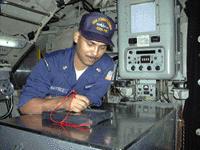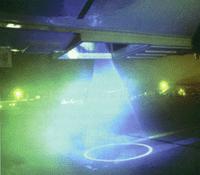by
Michael L. McHugh, Captain, U.S. Navy
With a
growing percentage of the Nation’s strategic nuclear
deterrent carried by the ballistic missile submarine
(SSBN) force, credible pre-launch survivability of the
SSBNs becomes a major strategic issue in its own right.
This is not a new concern, and the question of U. S.
submarine survivability was considered quite early in the
Cold War. Late in the 1960s, the Department of Defense
established a Vulnerability Task Force (VTF) to determine
how safe the “41 for Freedom” SSBN force would
be against enemy attempts to neutralize it before
launching its strategic missile payload. When the VTF
attempted to address this issue in all its generality,
however, it quickly realized there were too many gaps in
our knowledge of both the threat and the physical aspects
of underwater detection, tracking, and engagement to
arrive at a definitive answer.
This
finding was a “wake-up call” for our SSBN force
and naval strategic thinkers. It prompted then-Director,
Defense Research and Engineering, John S. Foster, Jr., to
issue a directive in October 1968 that established a
requirement to investigate technical issues arising in
the general area of SSBN vulnerability and survivability.
This was the beginning of the Navy’s SSBN Security
Program. Over the years, it has vigorously analyzed both
acoustic and non-acoustic undersea threats and, when
necessary, developed systems and tactics to counter them.
The SSBN Security Program Today
Today, the SSBN Security Program remains committed to its
original charter – ensuring the security of our SSBN
force now and well into the future. It consists of three
divisions devoted to potential acoustic and non-acoustic
vulnerabilities and operations security. The first two
pursue research and development projects in detection and
tracking, while the last focuses on non-technical,
operational aspects of SSBN security. Together they
comprise an active program of operations analysis,
laboratory research, at-sea tests, and countermeasures or
tactics development.
Acoustics and Non-Acoustics
The major efforts in these disciplines focus on the
physics that governs detection of submarines at sea and
on advanced technologies that might exploit these
phenomena to create new vulnerabilities for the SSBN
force. The resulting in-depth study of the undersea
environment has produced the “lion’s
share” of our science and technology base in
submarine detection and vulnerability. While the results
– and even the topics – of most of these
studies remain highly classified, a number of
unclassified program successes are highlighted in the
accompanying sidebar. These accomplishments have been as
important to the development of SSN and coordinated ASW
tactics as they were to maintaining SSBN survivability.
Operations Security
The Operations Security area of the SSBN Security Program
concentrates on monitoring, analyzing, and assessing
real-world SSBN operations to identify improved tactics
and techniques for raising the general security level of
deterrent patrols. There are four primary focus areas:
SSBN
Tactical Development Program
Operations
Characterization Project
Force
Security Assurance Project
SSBN
Operations Assessment
SSBN Tactical Development
Program (STDP)
Managed by Submarine Development Squadron Twelve in
coordination with the Johns Hopkins University’s
Applied Physics Laboratory (JHU/APL), the STDP develops
and evaluates new tactics for minimizing the vulnerabilty
of deterrent patrols. Successful new approaches, such as
those learned in formal at-sea exercises, are embodied in
the Submarine Security Manual. An active partnership in
the STDP with all SSBN crew members has been the real key
to maintaining the excellent security posture of the
deterrent force.
Operations Characterization
Project (OCP)
By continuously logging submarine operating parameters
during every deterrent patrol, the OCP provides
authoritative, real-world operations profiles for
post-mission assessment. Thus, after each patrol, every
SSBN receives a report that portrays its operating
practices in detail. At the heart of the OCP is the
Electronic Deck Log (EDL). Formerly, patrol data were
collected, collated, analyzed, and reported “by
hand.” In an effort to reduce manpower, save money,
and increase accuracy, JHU/APL developed the EDL, which
electronically logs and analyzes key parameters and
formats its own reports. The EDL also permits SSBN
Sailors to access its data, which include sonar,
Electronic Support Measures (ESM), and engineering
parameters for real-time analysis during the patrol.
Already, the EDL is “spinning off” new
technologies to other data-logging efforts and generating
the most comprehensive database of operational
information we have in the Fleet.
Force Security Assurance Project
(FSAP)
The FSAP focuses on “big-picture” issues that
go straight to the heart of submarine strategic
deterrence. A recent example is the “Foundations
Assessment,” which investigated whether today’s
SSBN force operates under assumptions appropriate to the
post-Cold War environment. This assessment spurred the
development of new operating premises better suited to
today’s conditions. Other assessments underway
include a study of the value of the SSBN in deterring
assymetric threats, such as information warfare and
chemical and biological weapons.
SSBN Operations Assessment (SOA)
Typical tasks within the SOA project involve the analysis
of individual unit-level and force-wide problems that
arise in estimating the threat, devising tactics, and
planning operations. Recent efforts
have included updating the threat to SSBNs from
state-of-the-art ASW capabilities, reviewing and
evaluating Standard Operating Procedures (SOPs) and
Operational Security (OPSEC) procedures, and studying
SSBN patrol patterns and their predictability. These
independent analyses of SSBN operations provide feedback
needed by commanders to assist them in employing the
force effectively in the post-Cold War era.
“14 for Freedom”
In comparison with our earlier force of “41 for
Freedom,” the SSBN fleet is slated to drop to 14
ships in the new century. With each individual platform
thus representing a significantly larger percentage of
America’s strategic deterrent, the importance of
ensuring the security of each becomes more important than
ever. Far from being an artifact of the Cold War, the
SSBN Security Program remains a key element in
maintaining the credibility of our strategic nuclear
arsenal.

A sailor from USS Pennsylvania (SSBN-735)
(GOLD), enters ship's data into the Elctronic Deck Log.
SSBN Security
Program Technology Highlights "Under
Wraps" No More
Acoustics
Passive
- Demonstrated first use of Fast Fourier
Transform (FFT) techniques for real-time
multi-channel beamforming and signal
processing
- Developed techniques for measuring
deviations of a long towed array from
straightness and demonstrated how these
could be compensated for in signal
processing
- First evaluated submarine detectability
in the 0.01 to 1.0 Hz infrasound region
- Quantified detectability of acoustic
transients in specific operating
evolutions and showed how these could be
exploited at low false alarm rates
- Determined the physical mechanisms that
give rise to submarine propulsion
signatures
Active
- First investigated potential of very
long-range, low-frequency active
acoustics, including impulsive source
technology, target strength, and shallow
water effects
- Demonstrated low-frequency bistatic
active echo ranging
- Developed first tactical decision aid for
low-frequency active acoustics

Non-Acoustics
Hydrodynamics
- Extensively investigated
submarine-induced hydro-dynamic signature
generation, propagation, and decay models
- Quantified detectability of submarine
hydrodynamic wakes
Electromagnetics
- Developed first validated models of radar
detection of submarine masts and antennas
and quantified their detectability
- Investigated the detection potential of
advanced airborne Magnetic Anomaly
Detection (MAD), including geologic
effects and noise cancellation
- Conducted first AC and DC electromagnetic
signature measurements on fully submerged
submarines
Infrared and Optics
- Identified previously observed infrared
surface “scars” as
manifestations of the submarine wake
- Developed first quantified
bioluminescence detection model
- Evaluated optical detectability of the
submarine hull and associated systems
- Employed first airborne digital laser
radar system to determine potential for
detecting submarine hulls
In
addition to these accomplishments in
understanding the physical phenomenology of
submarine detection and tracking, the SSBN
Security Program has also contributed
significantly to the characterization of the
natural ocean environment, its exploitation
for ASW, and the development of numerous ASW
tactical decision aids.
— Captain Mike
McHugh retired in 1998 after 30 years of
distinguished service. His last assignment
was as the SSBN Security Program Manager on
the staff of the Director, Submarine Warfare.
|
|
